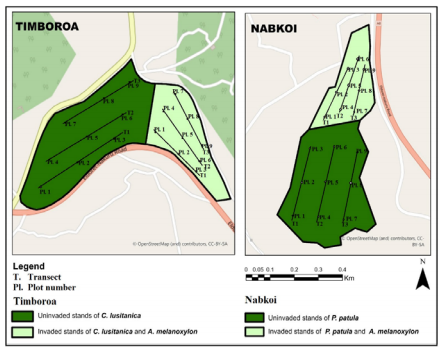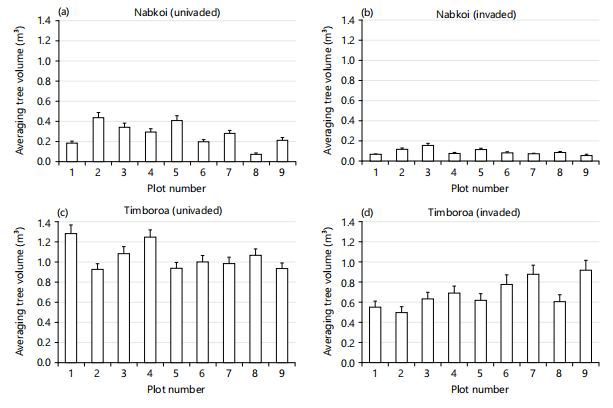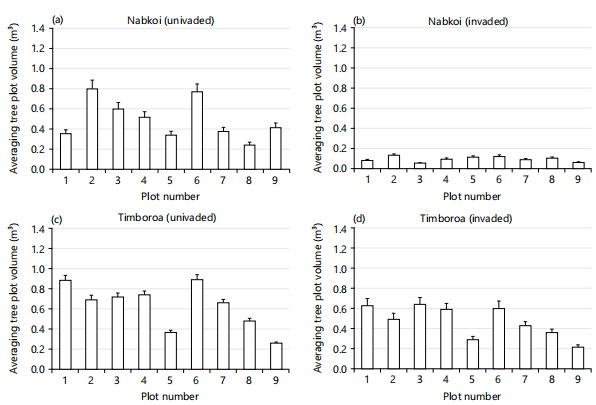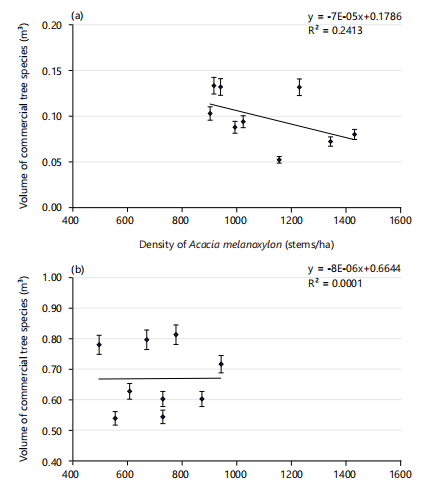Influence of Invasive Acacia melanoxylon on the Forest Stand Volumes and Annual Increment of Commercial Tree Species in Two Humid Forests (Nabkoi and Timboroa Forests, Kenya)
| Received 12 May, 2024 |
Accepted 13 Jun, 2024 |
Published 14 Jun, 2024 |
Background and Objective: The ecological relationship between Acacia melanoxylon invasion and forest ecology is not well understood in tropical humid forest ecosystems. Therefore, the main objective of this study was to determine the influence of Acacia melanoxylon on the volume and annual increment of two commercial forest tree species (Cupressus lusitanica and Pinus patula) in a humid tropical forest (North Tinderet Forest, in Kenya). Materials and Methods: Data were collected using a 10×10 m plot overlaid on a 500 m transect in univaded and invaded sites. Tree density, Diameter at Breast Height (DBH) >1.3 m and tree heights were measured. Volume and the mean annual biomass increment (MAI) were calculated. Results: There were significantly (p<0.05) higher tree densities, DBH and height in Timboroa than Nabkoi regardless of invasion. Further, the increased density of Acacia melanoxylon suppressed the volume of commercial tree species. These findings suggest that Acacia melanoxylon invasion reduced volume through reduced annual growth increment of commercial tree species. The proactive management of invasive Acacia melanoxylon should be considered to prevent the loss of tree volumes. Conclusion: However, the complexity of controlling both invasion and restoration side effects highlights the importance of taking a preventive approach.
| Copyright © 2024 Okoth et al. This is an open-access article distributed under the Creative Commons Attribution License, which permits unrestricted use, distribution, and reproduction in any medium, provided the original work is properly cited. |
INTRODUCTION
There have been a total of 443 tree species declared invasive by the Global Invasive Species Database (GISD)1,2. Countries in Sub-Saharan African Africa (SSA) have the highest number of invasive species3. Among the species reported in the regions, some species of acacia are listed in the land species category of 100 awful invasive alien species4. The genus Acacia (Mill.) (belongs to the family Fabaceae, subfamily Mimosoideae and includes roughly 1300 species5. The genus is broad, including segregate genera Senegalia and Vachellia but excluding Faidherbia. Acacia dominates the structure and floristic composition of woodland, wooded grassland and bushland6,7. The genus occurs across a wide range of ecosystems, from arid and semi-deserts, afro-montane forests, savannah grassland and plantation forests8,9.
It is not clear when some non-native acacia species were introduced in Kenya perhaps due to several species, each with an overlapping history10. There are 12 species of Acacia known in Kenya mostly introduced into specific areas for economic or environmental purposes11 and include Acacia tortilis, Senegalia mellifera, Vachellia reficiens, Acacia lahai, Senegalia senegal, Vachellia seyal, Vachellia drepanolobium, Acacia elatior, Vachellia xanthophlea, Acacia mearnsii, Acacia brevispica and Acacia melanoxylon. Among these, four acacia species including Acacia mearnsii, Acacia tortilis, Vachellia seyal and Acacia melanoxylon are confirmed as invasive although the level of extirpation they cause to the environment is not clear7,12,13.
A key aspect of the invasive biology of A. melanoxylon is the knowledge of their impacts on the native tree species. The proliferation of A. melanoxylon as an invasive species at the ecosystem level may lead to a reduction in tree growth parameters such as DBH and height growth, as well as changes in the biometric information14,15. In commercial forests, the tree value is determined using volume which is a function of the DBH and height of the tree16. In forests, A. melanoxylon may affect tree growth parameters.
In-depth studies of A. melanoxylon in forests should look at volume estimates and annual biomass increment17,18. Information on the influence of acacia species is determined by the type of species invading, habitat conditions, types of trees invaded as well as the environmental conditions19-22. Despite this, there are no meaningful studies conducted in Kenya’s plantation forest ecosystems to determine the response of tree volume estimates and annual biomass increment to A. melanoxylon invasion. Therefore, this study determined the influence of A. melanoxylon on the volume and annual increment growth of two commercial forest tree species (Cupressus lusitanica and Pinus patula) in the North Tinderet Forest, North Rift in Kenya. The study hypothesized that commercial timber tree species, C. lusitanica and P. patula within the proximity of invasive species such as A. melanoxylon will manifest in reduced volume and annual biomass increment.
MATERIALS AND METHODS
Study area: The study was conducted in the Nabkoi and Timboroa forests situated within the North Tinderet Forest in Uasin Gishu County (Kenya). It covers a total area of 3,345.2 km² with a population of 1,163,000. The areas occur within Longitude 34°50'E to 35°37'E and Latitudes 0°03'S to 0°55'N.
The climate of the area is typically tropical rainforest. The altitude ranges between 2600 to 2950 masl, however, Timboroa Forest (2913 masl) is at a higher altitude compared to Nabkoi Forest (2634 masl). Annual rainfall ranges between 1,328 to 1,405 mm. The cyclic pattern of rainfall is a long rainy season between March to June, dry season between July and September, short rainy season from October to November, followed by another dry season from December to February. Temperatures range from a minimum of 7°C (June-August) to a maximum of 29°C. The two study sites have exotic plantation species, mostly dominated by Cupressus lusitanica (Timboroa) and Pinus patula (Nabkoi). Within the mosaic of indigenous vegetation and the above commercial timber tree species is Acacia melanoxylon which appears to be spreading in the area including within cypress and pine plantations.
The geology is mainly composed of basalt rock boulders of pre-Cambrian formations. There are two main soil types: Soils of the plateaus (Ferralsols)-deep red well-drained soils-red and brown loam as well as the soils of the bottomlands (gleysols)-poorly drained soils-red and brown clay. The topsoil layer is mainly red loam soils rich in organic matter hence susceptible to erosion but suitable for agricultural activities and tree growing.
Selection of sampling sites: Field sites were selected based on altitude, slope and aspect. The study area was divided into two specific study sites from which data was collected. Nabkoi (2634 masl) and Timboroa (2913 masl) were chosen to represent the species of interest because of their difference in altitude and proximity (3-4 km apart) within the same forest formation of the study area. For each of the two study sites (Nabkoi and Timboroa) (i) Distinct stands Acacia melanoxylon, largely taken over natural vegetation, and23 stands for each of the two species of interest, Cupressus lusitanica and Pinus patula were appropriately identified and selected. The uninvaded and invaded stands of each species were compared, at the two sites. In summary, Nabkoi (Acacia melanoxylon stands, Cupressus lusitanica invaded and uninvaded stands; Pinus patula invaded and uninvaded stands and the same process repeated in Timboroa).
Forest sampling: The fieldwork was carried out from January, 2022 to February, 2023 covering both dry and rainy seasons. A reconnaissance survey was done from November to December, 2021 preceding the fieldwork to identify forest sites to be assessed. The method of systematic sampling was used to select sampling units. In the selected stands, three line transects were established taking into account slope orientation to capture horizontal and vertical variation. On each transect, 10×10 m plots were established located at 235 m intervals from which measurements were taken (Fig. 1).
Field measurements: Every tree in the sample plot (10×10 m) had its Diameter at Breast Height (DBH) measured, i.e., at 1.3 m above the ground using a diameter tape, taking the necessary precautions not to slant, or loosen the tape and measurements recorded in specially designed data collection forms labelled to indicate site, species (invaded or uninvaded) and plot number. Tree heights were measured using a Suunto clinometer (Suunto PM5/360PC) at a scale of 1:15 or 1:20).

|
Tree volume data: To assess stand volumes, tree models for Cupressus lusitanica and Pinus patula applicable to Kenya and routinely used by the Kenya Forest Service were applied to compute the volume of every tree measured within a plot. Tree volumes were then totaled to obtain plot volumes and the blow-up factor (1/size of the plot in hectares = 1/0.01 = 100) was reported on a per-hectare basis. Mean annual growth increments (MAI) for every stand found by dividing volume per hectare (from sample plots) by stand age. The tree volume models used were:
where, V is individual tree volume in m3 and D is diameter at breast height in cm and H is tree height in m.
Statistical analysis: Data collected were analyzed statistically using STATISTICA 8.0 and SPSS 23.0 statistical packages. In addition, Mean±SEM was used to summarize the trends in tree density, diameter size distribution, height, volume and MAI (on a per-hectare basis). Spatial trends were analyzed using one-way ANOVA followed by post hoc Duncan’s Multiple Range Test (DMRT). Results were declared significant at p<0.05.
RESULTS
The volume of P. patula and C. lusitanica were significantly (F(1, 82) = 8.457, df = 24 and p = 0.0034) higher in uninvaded sites compared to the invaded site at Nabkoi and Timboroa (Fig. 2).
The volume of P. patula at the invaded and uninvaded forest sites is provided in Fig. 3. The volume of P. patula was higher in uninvaded sites compared to the invaded sites at Nabkoi and Timboroa forest sites (F = 16.123, df = 24 and p = 0.0034). The volume of invaded is much more depressed in Nabkoi than in Timboroa.
The volume of commercial tree species relative to density of A. melanoxylon is shown in Fig. 4(a-b). There was a significant negative correlation (p<0.05) between the volumes of commercial tree species with A. melanoxylon density at all the forest sampling sites. Thus, as the density of the invasive species increased, the productivity of the planted species reduced.
Stand growth statistics for the two species are summarized in Table 1. Invaded stands volumes were drastically reduced compared to uninvaded stands. Mean annual biomass increments (MAI), (used for comparison to take into consideration age factor), increments of volume/ha for invaded stands as percent of uninvaded sites reduced by as much 38-85 in C. lusitanica and 60-77 in P. patula. For both species, lower altitude stands in Nabkoi were affected more than in Timboroa.
| Table 1: | Summarized stand data for the two commercial species in the study sites | |||
| Nabkoi | Timboroa | |||
| Species | Uninvaded | Invaded | Uninvaded | Invaded |
| Cupressus lusitanica | ||||
| Stand age (year) | 16.8 | 15.8 | 16.8 | 15 |
| Area (ha) | 20 | 20.3 | 15.8 | 15.9 |
| Density (stems/ha) | 1100 | 857 | 709 | 501 |
| Volume (m3/ha) | 600.4 | 83.2 | 457.1 | 252.8 |
| MAI (m3/ha/year) | 35.7 | 5.3 | 27.2 | 16.9 |
| Pinus patula | ||||
| Stand age (year) | 16.8 | 15.8 | 16.8 | 15.8 |
| Stand area (ha) | 15.8 | 10.2 | 15.7 | 10.6 |
| Density (stems/ha) | 1152 | 690 | 724 | 402 |
| Volume (m3/ha) | 336.5 | 73.5 | 781.7 | 290 |
| MAI (m3/ha/year) | 20 | 4.7 | 46.5 | 18.4 |

|

|

|
DISCUSSION
The volume and MAI of the commercial tree species (P. patula and C. lusitanica) were higher in uninvaded sites compared to the invaded sites at Nabkoi and Timboroa forest sites. This suggests that A. melanoxylon invasion negatively affected the volume of commercial tree species. There are several mechanisms that invasive plants including acacias might use to reduce the overall tree productivity of other species. First, is competition for resources between invasive and native plants which is a crucial process in the competitive interactions that may ultimately affect native vegetation patterns of growth and biomass increments24. Invasive plants also appeared to modify the ecosystem’s abiotic processes, like hydrology and disturbance regimes which tend to lower biomass increase and volume25.
Most acacia species inhibit the growth of other plant species through chemical interference or allelopathy which has been reported to reduce biomass increment in trees26. Most species of invasive acacia have allelochemicals in roots, stems, flowers and leaves which may affect the volume of trees in ways that are still not determined due to few studies in this realm. The results of the current study suggested that the invasion by A. melanoxylon reduced the volume of C. lusitanica and P. patula in the plantation forests.
It is also possible that A. melanoxylon has a strong impact on resource availability and soil or microclimatic characteristics, as suggested in several studies throughout the world27-29. In many areas, competition exclusion affects canopy cover and competition for growth resources such as light intensity, air temperature and humidity, which will eventually affect the growth of forest-adjacent trees30. Therefore, the current study seems to suggest that A. melanoxylon affects the growth of adjacent forest trees through competitive exclusion.
CONCLUSION
The study concluded that the comparison of uninvaded and invaded forest stands, the volume and the mean annual increment (MAI) in invaded sites was depressed by as low as 35% in higher altitudes and 85% at the lower altitudes depicting a reduction in volume due to A. melanoxylon invasion was dependent on the altitude. Further, as the number of individual trees of A. melanoxylon (density) increased in the stand, there was a corresponding decline in commercial species volume. The proactive management of invasive A. melanoxylon should be considered to prevent the loss of tree volumes. However, the complexity of controlling both invasion and restoration side effects highlights the importance of taking a preventive approach.
SIGNIFICANCE STATEMENT
In the forest, there may be accidental or deliberate introductions of invasive species, which may negatively or positively affect the forest ecosystem. The main concern of invasive species is their effect on the growth and establishment of commercial tree species, which may generally affect the overall volume of forest products. This study aimed to determine how invasive species affect the volume of commercial forest plantations. The study was conducted in a humid forest in Kenya for 13 months. The study established that in areas that were invaded by acacia, the volume was lower and therefore concluded that invasion reduced the volume of commercial tree species. The information is useful for the management of commercial forest plantations to enhance the wood industry.
ACKNOWLEDGMENTS
The authors acknowledge the Kenya Forest Service and Kenya Forestry Research Institute (KEFRI) for administrative and technical support during data collection. We also thank the University of Eldoret for providing expertise and equipment during data collection and analysis.
REFERENCES
- Girmay, M., K. Gebrehiwot, E. Atinafe, Y. Tareke and B. Belay, 2024. The study of exotic and invasive plant species in Gullele Botanic Garden, Addis Ababa, Ethiopia. J. Zool. Bot. Gardens, 5: 36-50.
- Meerdink, S., D. Hiatt, S.L. Flory and A. Zare, 2024. Dealing with imperfect data for invasive species detection using multispectral imagery. Ecol. Inf., 79.
- Boonman, C.C.F., J.M. Serra-Diaz, S. Hoeks, W.Y. Guo and B.J. Enquist et al., 2024. More than 17,000 tree species are at risk from rapid global change. Nat. Commun., 15.
- Alemayehu, B., J. Suarez-Minguez and J. Rosette, 2024. Modeling the spatial distribution of Acacia decurrens plantation forests using planetscope images and environmental variables in the northwestern highlands of Ethiopia. Forests, 15.
- Pasha, S.V. and C.S. Reddy, 2024. Global spatial distribution of Prosopis juliflora-one of the world’s worst 100 invasive alien species under changing climate using multiple machine learning models. Environ. Monit. Assess., 196.
- Ojoatre, S., J. Barlow, S.R. Jacobs and M.C. Rufino, 2024. Recovery of aboveground biomass, soil carbon stocks and species diversity in tropical montane secondary forests of East Africa. Forest Ecol. Manage., 552.
- Richardson, D.M., P. Binggeli and C. Botella, 2023. Australian Acacia Species in Africa. In: Wattles: Australian Acacia Species Around the World, Richardson, D.M., J.J. Le Roux and E. Marchante (Eds.), CABI International, Wallingford, United Kingdom, ISBN: 978-1-80062-217-3, pp: 181-200.
- Hagwet, M.B., H.J. Ndangalasi and S.M. Andrew, 2024. The relationship between the abundance of non-native tree species and the community structure of resident woody species in tropical montane forest of West Usambara Mountains, Tanzania. Environ. Challenges, 14.
- Kiptoo, T.K. and J.L.O. Kiyiapi, 2023. Impacts of invasive species on commercial forest plantations in Africa-A review. J. Aquat. Terr. Ecosyst., 1: 56-65.
- Shackleton, R.T., D.M. Richardson, C.M. Shackleton, B. Bennett and S.L. Crowley et al., 2019. Explaining people's perceptions of invasive alien species: A conceptual framework. J. Environ. Manage., 229: 10-26.
- Farrer, E.C., C. Birnbaum, P. Waryszak, S.R. Halbrook and M.V. Brady et al., 2021. Plant and microbial impacts of an invasive species vary across an environmental gradient. J. Ecol., 109: 2163-2176.
- Wilgan, R., 2021. Dual and Tripartite Symbiosis of Invasive Woody Plants. In: Symbiotic Soil Microorganisms: Biology and Applications, Shrivastava, N., S. Mahajan and A. Varma (Eds.), Springer, Cham, Switzerland, ISBN: 978-3-030-51916-2, pp: 87-97.
- Yapi, T.S., P.J. O’Farrell, L.E. Dziba and K.J. Esler, 2018. Alien tree invasion into a South African montane grassland ecosystem: Impact of Acacia species on rangeland condition and livestock carrying capacity. Int. J. Biodivers. Sci. Ecosyst. Serv. Manage., 14: 105-116.
- Guareschi, S., T. Cancellario, F.J. Oficialdegui and M. Clavero, 2024. Insights from the past: Invasion trajectory and niche trends of a global freshwater invader. Global Change Biol., 30.
- Sarr, M.S., J.R. Seiler and J. Sullivan, 2024. Effect of drought stress on the physiology and early growth of seven Senegalia (Acacia) Senegal (L.) Britton provenances. New Forests, 2024.
- de Lima, R.B., E. Rutishauser, J.A.A. da Silva, M.C. Guedes and B. Herault et al., 2021. Accurate estimation of commercial volume in tropical forests. Forest Sci., 67: 14-21.
- Lowry, B.J., J.H. Lowry, K.J. Jarvis, G. Keppel, R.R. Thaman and H.J. Boehmer, 2020. Spatial patterns of presence, abundance, and richness of invasive woody plants in relation to urbanization in a tropical island setting. Urban For. Urban Greening, 48.
- Kusmana, C. and I. Suwandhi, 2019. Diversity of plant species and the presence of Invasive Alien Species (IAS) in the Sub-Montane Forest at Pakenjeng Region, Southern Part of Garut, West Java. IOP Conf. Ser.: Earth Environ. Sci., 399.
- Jansen, C. and S. Kumschick, 2022. A global impact assessment of Acacia species introduced to South Africa. Biol. Invasions, 24: 175-187.
- Erckie, L., O. Adedoja, S. Geerts, E. van Wyk and J.S. Boatwright, 2022. Impacts of an invasive alien Proteaceae on native plant species richness and vegetation structure. South Afr. J. Bot., 144: 332-338.
- Matos, F.A.R., D.P. Edwards, L.F.S. Magnago, G. Heringer and A.V. Neri et al., 2023. Invasive alien acacias rapidly stock carbon, but threaten biodiversity recovery in young second-growth forests. Phil. Trans. R. Soc. B, 378.
- Impson, F.A.C., J.H. Hoffmann, O.R. Impson, C.A. Kleinjan and V.C. Moran, 2024. Densities of a perennial invasive tree, Acacia cyclops, decline in the 20 years since inception of biological control with two seed-reducing agents, a flower-galling midge and a seed-feeding weevil. Biol. Control, 189.
- Chadin, I., I. Dalke, I. Zakhozhiy, R. Malyshev and E. Madi et al., 2017. Distribution of the invasive plant species Heracleum sosnowskyi Manden. in the Komi Republic (Russia). PhytoKeys, 77: 71-80.
- Oduor, A.M.O., 2013. Evolutionary responses of native plant species to invasive plants: A review. New Phytologist, 200: 986-992.
- Levine, J.M., P.B. Adler and S.G. Yelenik, 2004. A meta-analysis of biotic resistance to exotic plant invasions. Ecol. Lett., 7: 975-989.
- Hussain, M.I., M.A. El-Sheikh and M.J. Reigosa, 2020. Allelopathic potential of aqueous extract from Acacia melanoxylon R. Br. on Lactuca sativa. Plants, 9.
- Kumschick, S. and C. Jansen, 2023. Evidence-Based Impact Assessment for Naturalized and Invasive Australian Acacia Species. In: Wattles: Australian Acacia Species Around the World, Richardson, D.M., J.J. Le Roux and E. Marchante (Eds.), CABI International, Wallingford, England, ISBN: 978-1-80062-217-3, pp: 359-381.
- Liu, S., J. Streich, J.O. Borevitz, K.J. Rice, T. Li, B. Li and K.J. Bradford, 2019. Environmental resource deficit may drive the evolution of intraspecific trait variation in invasive plant populations. Oikos, 128: 171-184.
- de los Ángeles García-Hernández, M. and F. López-Barrera, 2024. Direct seeding success of four threatened oak species in a peri-urban forest: Effects of microhabitat and rodent exclusion. Forest Ecol. Manage., 553.
- Kohli, R.K., K.S. Dogra, D.R. Batish and H.P. Singh, 2004. Impact of invasive plants on the structure and composition of natural vegetation of Northwestern Indian Himalayas. Weed Technol., 18: 1296-1300.
How to Cite this paper?
APA-7 Style
Okoth,
E.O., Kiptoo,
T.K., Kiyiapi,
J.L., Sang,
F.K. (2024). Influence of Invasive Acacia melanoxylon on the Forest Stand Volumes and Annual Increment of Commercial Tree Species in Two Humid Forests (Nabkoi and Timboroa Forests, Kenya). Research Journal of Forestry, 18(1), 1-9. https://doi.org/10.3923/rjf.2024.1.9
ACS Style
Okoth,
E.O.; Kiptoo,
T.K.; Kiyiapi,
J.L.; Sang,
F.K. Influence of Invasive Acacia melanoxylon on the Forest Stand Volumes and Annual Increment of Commercial Tree Species in Two Humid Forests (Nabkoi and Timboroa Forests, Kenya). Res. J. For 2024, 18, 1-9. https://doi.org/10.3923/rjf.2024.1.9
AMA Style
Okoth
EO, Kiptoo
TK, Kiyiapi
JL, Sang
FK. Influence of Invasive Acacia melanoxylon on the Forest Stand Volumes and Annual Increment of Commercial Tree Species in Two Humid Forests (Nabkoi and Timboroa Forests, Kenya). Research Journal of Forestry. 2024; 18(1): 1-9. https://doi.org/10.3923/rjf.2024.1.9
Chicago/Turabian Style
Okoth, Elijah, Oyoo, Thomas Kiprotich Kiptoo, James Legilisho Kiyiapi, and Francis Kiptarus Sang.
2024. "Influence of Invasive Acacia melanoxylon on the Forest Stand Volumes and Annual Increment of Commercial Tree Species in Two Humid Forests (Nabkoi and Timboroa Forests, Kenya)" Research Journal of Forestry 18, no. 1: 1-9. https://doi.org/10.3923/rjf.2024.1.9

This work is licensed under a Creative Commons Attribution 4.0 International License.

